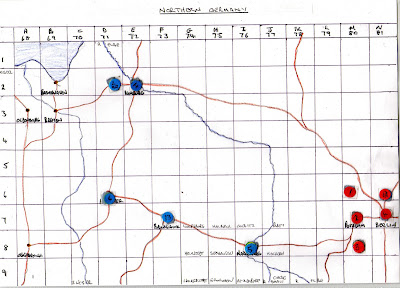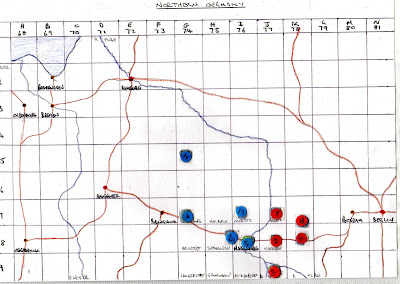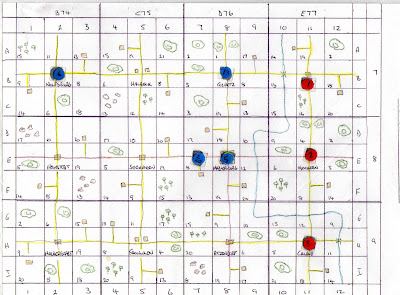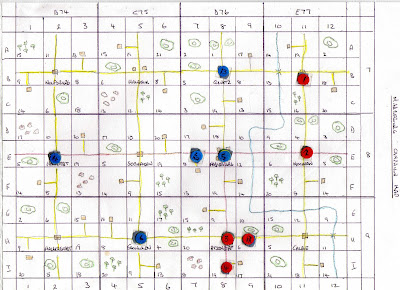I have five campaigns on the go at present. However I will only use one to illustrate campaign movement. I will use the campaign in northern Germany, as I have already used the maps for this campaign in earlier posts.
The campaign is loosely based on 1813. The aim is not to recreate the historical campaign, it is to provide a campaign setting which will produce the size and type of wargames I wish to play.
The campaign area is from Osnabruck to Berlin. The Second French army, consisting of 4 corps, have orders to hold the river Elbe from Hamburg to Madgeburg. The Prussian Army, also consisting of 4 corps, have orders to advance from Berlin and capture Madgeburg.
In order to reduce paperwork to a minimum I only keep a hard copy of the Strategic and Tactical maps in the campaign folder. All orders are controlled on the computer.
Maps and markers
The map is drawn on a sheet of A4 paper, which is then placed inside a transparent A4 folder. In my example there are five markers each side, red are allied and blue French. Four markers represent the four corps on each side, the fifth is the Army HQ. I stick a blob of bluetac on the back of each marker, and they can be moved around the map without doing any damage.
Strategic movement
The campaign starts on 1 May when the Prussians start their advance from Berlin to Madgeburg. Orders, which are very simple, are written before any movement. Prussians move first, French can not react until the following day. Movement rate is 1 square per day. Maps indicate position at end of each day.
Strategic map 1 May 1813
Second French army is deployed to hold the river Elbe from Hamburg to Madgeburg
The Prussian army has started its advance from Berlin to the river Elbe

Prussian Army - move to river Elbe and occupy Madgeburg
1 Prussian corps - move to M6
2 Prussian corps - move to M7
3 Prussian corps - move to M8
4 Prussian corps - move to N7
Second French Army - Hold line of river Elbe from Hamburg to Madgeburg
4 French corps - hold Hamburg
5 French corps - hold Madgeburg
6 French corps - hold Hannover
13 Polish corps - hold Brunswick
Strategic map 4 May 1813
Second French army is moving towards the river Elbe
Prussian army has reached the river Elbe and is about to cross
Prussian army - move to river Elbe and occupy Madgeburg
1 Prussian corps - move to J7
2 Prussian corps - move to J8
3 Prussian corps - move to J9
4 Prussian corps - move to K8
Second French army - hold river Elbe from Hamburg to Madgeburg
4 French corps - move to G5
5 French corps - hold Madgeburg
6 French corps - move to G7
13 Polish corps - hold I7

Tactical Movement 4 May 1813
Because the two armies are now within three strategic squares of each other, and neither are prepared to retreat, the first Tactical map is now made. It covers the 12 Strategic squares 74-7, 74-8, 74-9, 75-7, 75-8, 75-9, 76-7, 76-8, 76-9, 77-7, 77-8 and 77-9. Only the corps on those squares on the Strategic map are transferred to the Tactical map
Tactical Map 4 May 1816
Second French army is moving towards the river Elbe
Prussian army has reached the river Elbe, 3 corps has already crossed the river in the south

1 Prussian corps - move to B11
2 Prussian corps - move to E11
3 Prussian corps - move to H11
5 French corps - hold Madgeburg
6 French corps - move to B2
13 Polish corps - move to B8
Tactical Map 8 May
Second French army is moving south towards Groningen to halt Prussian advance
Prussian army has crossed the river Elbe at Calbe and is about to attack Groningen

Prussian HQ - Atzendorf
1 Prussian corps - hold B11
2 Prussian corps - hold E11
3 Prussian corps - move to H8
4 Prussian corps - move to I8
French HQ - Madgeburg
4 French corps - move to E2
5 French corps - hold E8
6 French corps - move to H5
13 Polish corps - hold B8
What happens next?
3 and 4 Prussian corps are about to attack 6 French corps at Groningen. The wargames table will be set up with a 3x3 square centered on Groningen, figures will be placed on the table in the squares shown on the tactical map. 4 French corps will arrive in square G4 on move 8.
Before the wargame is fought, orders will be written for all corps not taking part in the battle for 9 May 1813.
When the wargame ends, final positions on the table will be transferred to the Tactical map and orders written for the corps taking part for 9 May 1813.








